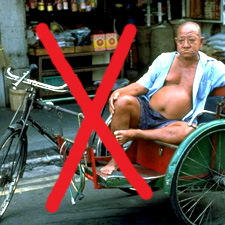| Buying Your First Road Bike |

SEACOAST CYCLING
No cheesy or weird bikes here. The author offers quick tips for the serious recreational rider who is out shopping for the best value. Spend like you’re serious about riding, says the Great Balkini. Time to put the three-speed in the shed.
About the Great Balkini
You have to start somewhere. People always ask me -- what is the "right" price for a "good bike" that is a truly decent piece of sporting equipment. Here's my view:
Sub 21-pound road bikes sell for $1,500 up to $5,000 and you can pay even more for custom-made bikes that are more about passion, exclusivity and bragging rights than increased performance. There is nothing wrong with that, but it’s not what developing riders need to think about.
Built-up frames with recognizable brand names are the real deal. They come in a wide array of sizes that can easily be tweaked by a bike shop to meet your needs. Adjusting the bars, stem and seat achieves a virtual custom fit. The absolute best value for those used to the best in sporting goods equipment is any $2,500 bike equipped with top tier Campagnolo or Shimano components. For an individual to buy the same parts and hang them on an equivalent frame costs about $1,000 more since manufacturers buy tons of groups at a fraction of retail and pass the savings along.
The hardware that the pros race works with precision unknown to lower-tier riders. In everyday riding the benefit is nailing every shift. That enables a rider to smoothly maintain momentum while conserving energy. That is important since maintaining momentum is the essence of riding. Also, racing equipment used recreationally works as well for years with minimal maintenance.
The pros ride this hardware 15,000 training miles or more in a season and then race it in all kinds of weather over seemingly impossible distances. No recreational cyclist makes those demands and none can begin to approximate the power the pros put to the pedals. For those spending time on a bike the extra expense is well worthwhile.
On the low end of the spectrum is a $600 Trek road bike with a flame paint job. It’s light and sharp looking. It is good for an occasional spin, but it’s just not up for a long-term effort.
These bikes work well enough, but some gears cannot be accessed without undue strain, if at all, no matter how carefully they have been assembled. Frame flex and far less precisely made components make all sorts of noises under pressure and its diminished performance gets in the way. Don’t sell yourself short.
Think like a golfer and shop with a mindset that envisions a day when you’re going to be good enough for the equipment to matter. Stepping up to a better bike may not exactly be the waste you’re convinced it will be.
$1,500 is really the entry level for a developing rider who wants an honest chance at becoming proficient on a bike. While there appears to be a welter of choices, the process is actually quite simple. Lightweight frames of aluminum, titanium, carbon fiber and combinations thereof, are made by dozens of companies, most of which are not household names so beware when it comes to guarantees.
Ride characteristics vary by material, but take that with a grain of salt as decent riders are comfortable on anything and that’s where you’re headed. Aluminum is the cheapest to build with but, that doesn’t mean it is inferior. All of the frame materials are strong enough for the use intended. Still, guarantees are important as light equipment sometimes breaks, especially when heavier riders chunk them over rough roads. Lifetime frame guarantees are very cool.
Brands like Trek and Specialized and a host of lesser names build frames to meet a few price points and then hang them with a parts group to match. These companies watch each other closely and all offer similar dollar values. Shimano and Campagnolo are "it" for new road bikes and both enjoy strong advocacy among cyclists, because both work well and last a long time. You can’t go wrong with either.
New is the only way to go, not used. There are too many synergistic parts that cease working smoothly when mechanical and maintenance issues are left unattended. Police auction bikes are hopeless. Any bike that shows signs that it has been put away wet suffers from significant wear that can never be made right.
Buy in a shop where the bike shop workers ride. You can be sure that their bikes work perfectly. Spend $1,500 on a new bike from these guys and yours will too. Running a bike retail business, by the way, is more about the lifestyle than becoming wealthy. Small volume retailers work on slim-to-modest margins. Deal with people who know and love bikes. The advantage to the consumer is priceless.
Copyright (c) 2005 by David Balkin. All rights reserved.
